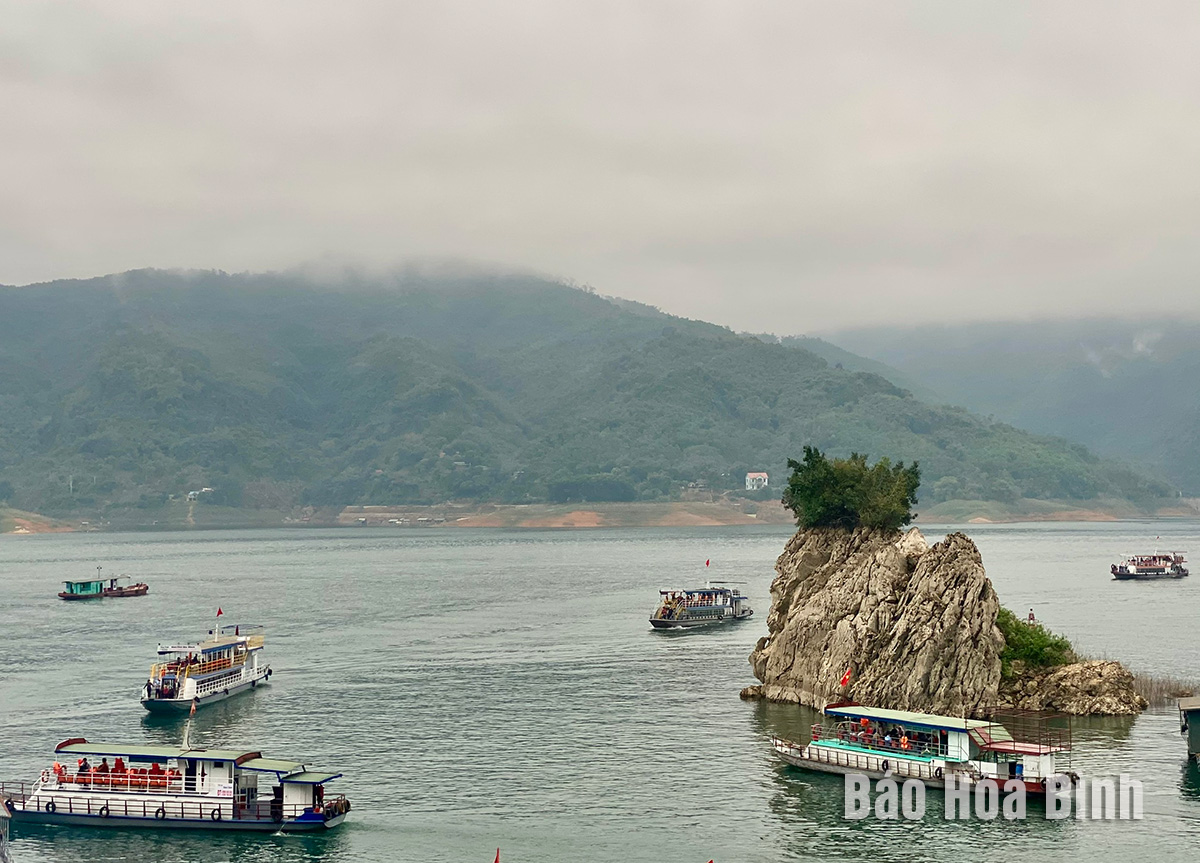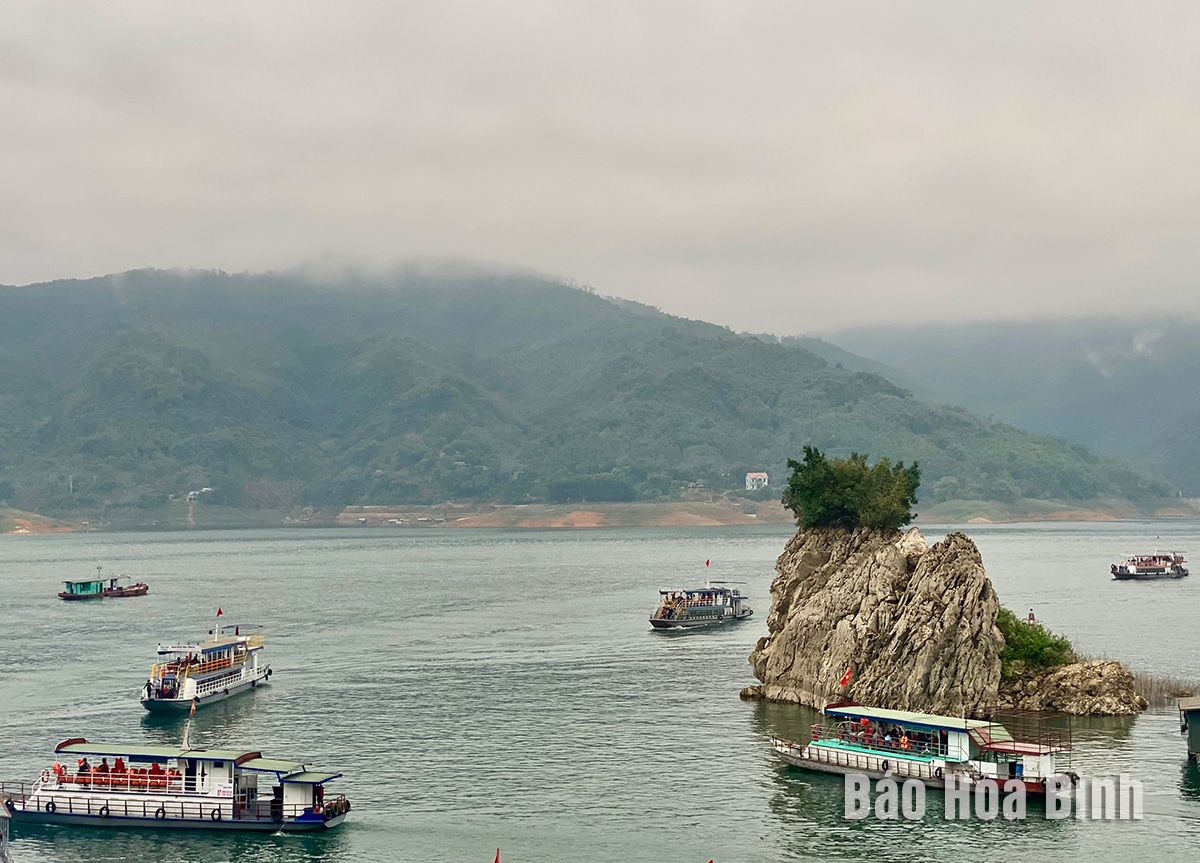
Covering an area of over 52,000 hectares spanning districts of Mai Chau, Tan Lac, Cao Phong, Da Bac, and Hoa Binh City, Hoa Binh lake has strong potential for tourism development. In recent years, thanks to the attention of local Party Committees and authorities as well as support from international organisations, the advantages of tourism in the lake area have been utilised.
Hoa Binh Lake attracts visitors with its natural scenery.
Abundant resources
Coming to Hoa Binh Lake, domestic and international tourists were amazed by the majestic beauty of hundreds of large and small islands nestled amidst the emerald green water which is reminiscent of a "Ha Long Bay in the mountains". It also features a system of caves with various shapes and mesmerising colors.
Hoa Binh Lake boasts numerous tourist attractions, historical and cultural sites, and spiritual tourism sites. The most popular destinations are Thac Bo Temple in Cao Phong District, Thac Bo Cave in Tan Lac District, Hoa Binh Phat Quang Pagoda in Hoa Binh City, Ngoc Hoa Bay, Hoa Tien Cave, Ngoc Island Ecotourism site, Coconut Island, and many villages of Muong and Dao ethic people where traditional culture is still preserved. These are cultural resources for tourism development.
Establishment of community-based tourism destinations
Ten years ago, the Australian non-governmental organisation Action on Poverty (AOP) in Vietnam collaborated with Da Bac District’s administration to carry out community-based tourism project in the locality, in which Da Bia village in Tien Phong commune was chosen as pilot implementation.
According to Dinh Thi Yeu, one of households that take part in the project, in the past, local residents’ livelihoods were dependent on forest plantations and fishing on the lake, thus most of them suffered financial difficulty. With financial support from the project and the government, households have upgraded their stilt houses to provide homestay services for visitors, she said, adding that they have been provided with tourism-related knowledge through training sessions. Cultural values have been preserved while traditional crafts have been revived, she added.
Da Bia has become a famous community-based tourism site. Especially, it is one of the three sites of Vietnam that received the ASEAN Tourism Awards on community-based tourism category at the Asia Travel Forum (ATF) in Hong Kong, China in 2019.
Pham Thu Hoai, a tourist from Hanoi, said Da Bia left a deep impression on her through experiencing locals’ daily activities, adding that she is satisfied with the living space at homestays and services there.
Through capacity-building support, other community-based tourism sites around the lake have been formed and put into operation, including Mo Hem in Tien Phong commune, Ke in Hien Luong commune, Sung in Cao Son commune (Da Bac), Ngoi in Suoi Hoa commune (Tan Lac), Tien in Thung Nai commune (Cao Phong) and Bich Tru in Hoa Binh commune (Hoa Binh City).
Attractive ecological sites
With its unique natural landscape, the Hoa Binh Lake area has been an idea places for organisations, individuals, and businesses to develop eco-tourism.
Mai Chau Hideaway Resort in Mai Chau district’s Son Thuy commune is an example. Describing as a small bay surrounded by green mountains nestled in the heart of the lake, it has become a popular destination to visitors, especially foreign ones.
According to Dang Tuan Hung, Head of Cultural Management Division under the Department of Culture, Sports and Tourism, the establishment of community-based villages and resorts have brought a facelift to the area. Each destination has its own charm, offering tourists a diverse range of products, such as resort and spiritual tourism, experiential travel which involves in the activities and daily life of the locals, such as rowing and swimming on the lake, or trekking through pristine forests and immersing themselves in the lively dances of the friendly Muong and Dao young men and ladies.
The Hoa Binh Lake tourist site has gradually expanded its connectivity with other destinations in the province and waterway routes on the Da River to neighbouring provinces of Hoa Binh, Son La, Dien Bien and Lai Chau. In 2019, it welcomed 550,000 tourists, accounting for 17.7% of the total arrivals to the province, including 26,000 international visitors. The total revenue from the tourism sector reached 160 billion VND (nearly 6.4 million USD).
A diverse chain of eco-tourism and resort destinations concentrated in Hoa Binh city and the districts of Tan Lac, Da Bac, and Luong Son… Along with the launch of several key high-quality resort tourism projects, these developments have reshaped the landscape and enhanced the appeal of Hoa Binh as a travel destination.
Boasting diverse terrain, a mild climate, and rich natural resources, Cao Phong district is increasingly asserting its place on Vietnam’s tourism map, attracting both domestic and foreign visitors. The district is renowned for its stunning landscapes, majestic mountains, a crystal-clear hydropower lake, and the unique cultural identity of local ethnic groups.
With its pristine landscapes, unique cultural heritage of Muong ethnic minority, and an expanding range of visitor experiences, Tan Lac district of Hoa Binh has fast become a captivating destination for both domestic and international tourists.
Until now, Sung village in Cao Son commune, Da Bac district remains the only Dao ethnic community in Hoa Binh province to develop a community-based tourism model. Beyond its untouched natural landscapes, cultural identity serves as the cornerstone attraction for visitors.
Alongside the diverse cultural identities of the Kinh, Muong, Tay, Thai, Dao, and Mong ethnic people, Hoa Binh province is also renowned as the "capital" of the northwestern Vietnamese cuisine, offering unique and distinctive dishes. At festivals, during Lunar New Year (Tet), or on significant family or community occasions, special dishes are prepared, leaving a lasting impression on visitors.
A Phong Linh (Yellow Tabebuia) flower garden in Thang village, Thach Yen commune, Cao Phong district is currently in full bloom, drawing a large number of visitors.



